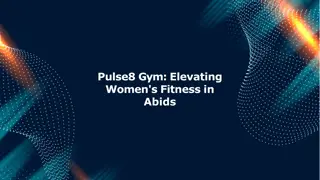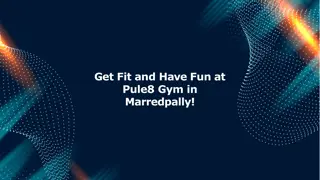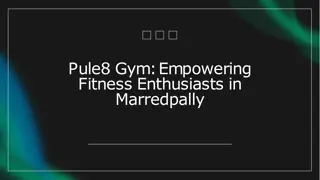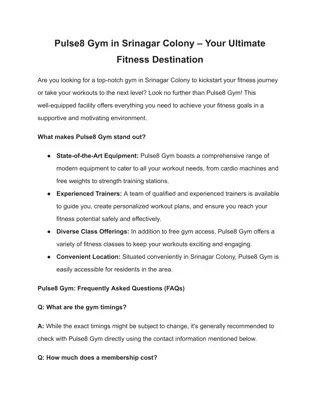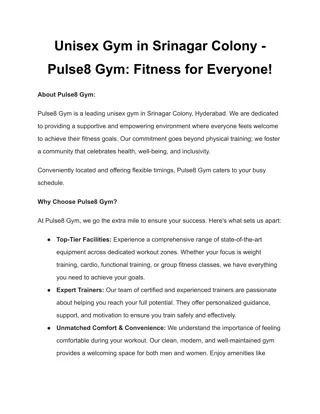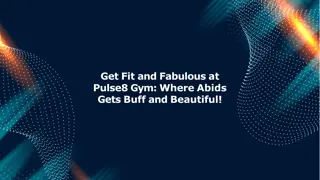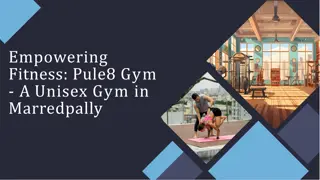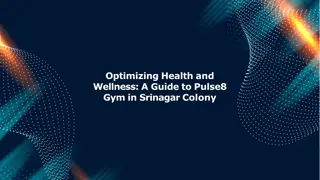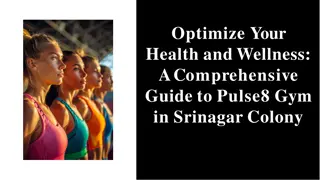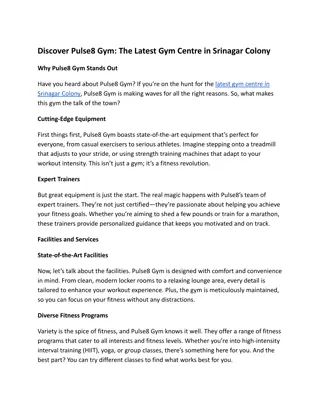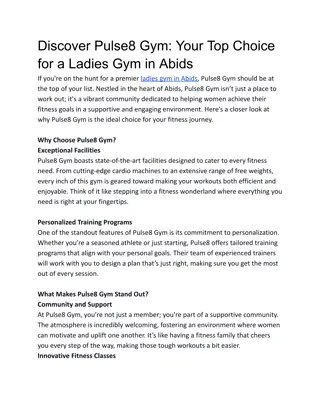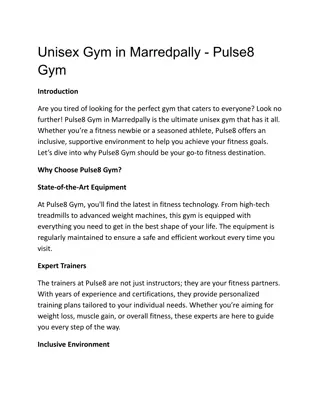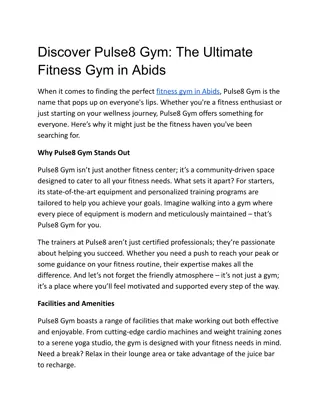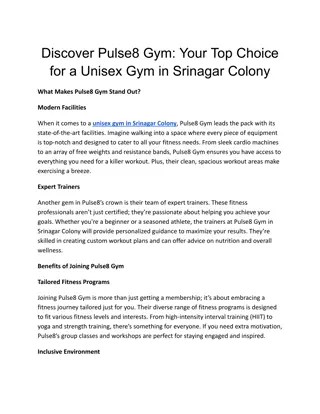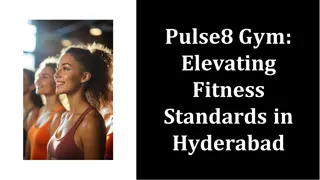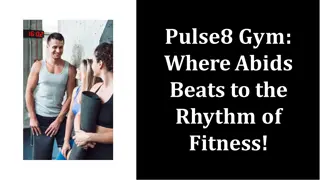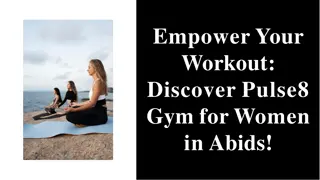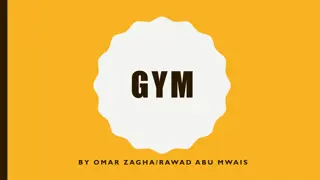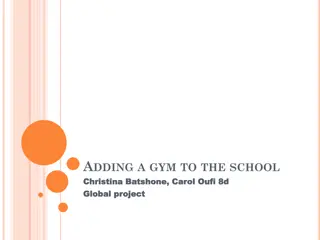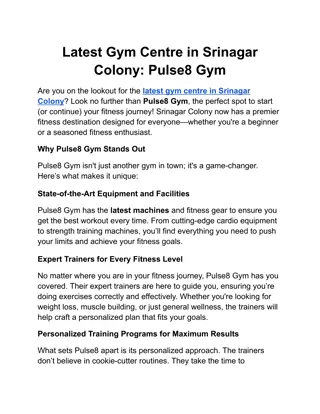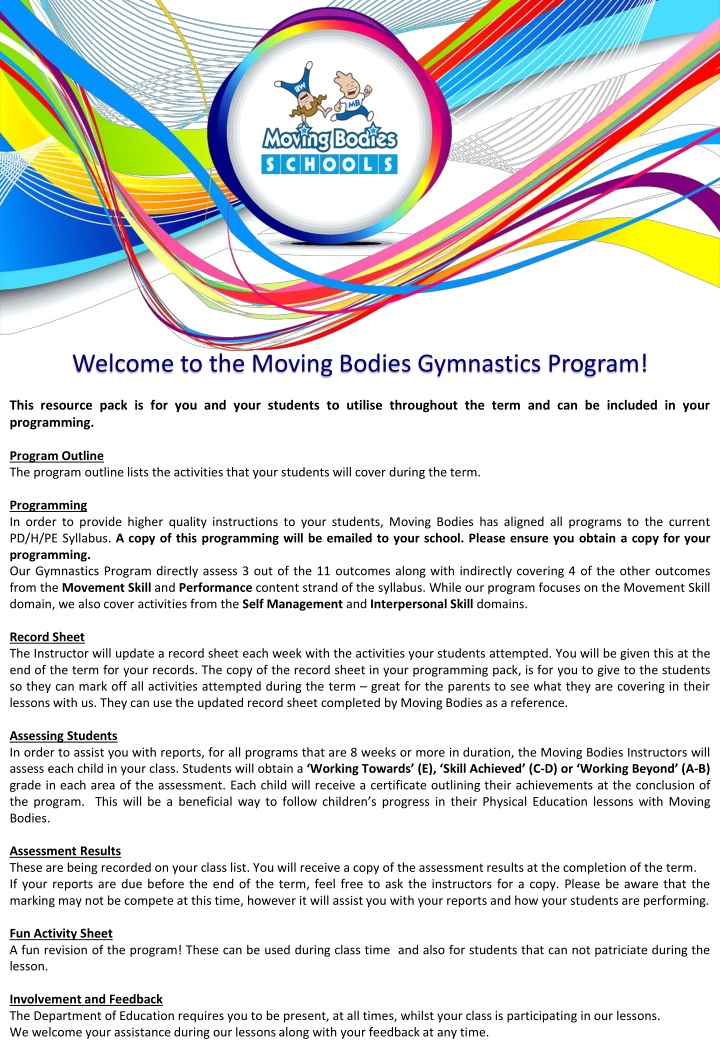
Gymnastics Program Objectives and Content Summary
"Explore the objectives, outcomes, and content of the Gymnastics Program for Early Stage 1, focusing on movement skills and performance. Students will develop confidence, competence, and creativity in various physical activities while enhancing their understanding of body movements and spatial awareness."
Download Presentation

Please find below an Image/Link to download the presentation.
The content on the website is provided AS IS for your information and personal use only. It may not be sold, licensed, or shared on other websites without obtaining consent from the author. If you encounter any issues during the download, it is possible that the publisher has removed the file from their server.
You are allowed to download the files provided on this website for personal or commercial use, subject to the condition that they are used lawfully. All files are the property of their respective owners.
The content on the website is provided AS IS for your information and personal use only. It may not be sold, licensed, or shared on other websites without obtaining consent from the author.
E N D
Presentation Transcript
Welcome to the Moving Bodies Gymnastics Program! This resource pack is for you and your students to utilise throughout the term and can be included in your programming. Program Outline The program outline lists the activities that your students will cover during the term. Programming In order to provide higher quality instructions to your students, Moving Bodies has aligned all programs to the current PD/H/PE Syllabus. A copy of this programming will be emailed to your school. Please ensure you obtain a copy for your programming. Our Gymnastics Program directly assess 3 out of the 11 outcomes along with indirectly covering 4 of the other outcomes from the Movement Skill and Performance content strand of the syllabus. While our program focuses on the Movement Skill domain, we also cover activities from the Self Management and Interpersonal Skill domains. Record Sheet The Instructor will update a record sheet each week with the activities your students attempted. You will be given this at the end of the term for your records. The copy of the record sheet in your programming pack, is for you to give to the students so they can mark off all activities attempted during the term great for the parents to see what they are covering in their lessons with us. They can use the updated record sheet completed by Moving Bodies as a reference. Assessing Students In order to assist you with reports, for all programs that are 8 weeks or more in duration, the Moving Bodies Instructors will assess each child in your class. Students will obtain a WorkingTowards (E), SkillAchieved (C-D) or WorkingBeyond (A-B) grade in each area of the assessment. Each child will receive a certificate outlining their achievements at the conclusion of the program. This will be a beneficial way to follow children s progress in their Physical Education lessons with Moving Bodies. Assessment Results These are being recorded on your class list. You will receive a copy of the assessment results at the completion of the term. If your reports are due before the end of the term, feel free to ask the instructors for a copy. Please be aware that the marking may not be compete at this time, however it will assist you with your reports and how your students are performing. Fun Activity Sheet A fun revision of the program! These can be used during class time and also for students that can not patriciate during the lesson. Involvement and Feedback The Department of Education requires you to be present, at all times, whilst your class is participating in our lessons. We welcome your assistance during our lessons along with your feedback at any time.
Gymnastics Program Early Stage 1 Movement Skill & Performance in Gymnastics OBJECTIVE OUTCOMES Demonstrate an understanding of movements skills, concepts and strategies to respond confidently, competently and creatively in a variety of physical activity contexts PDe-4 Practises and demonstrates movement skills and sequences using different body parts PDe-5 Explores possible solutions to movement challenges through participation in a range of activities Move with confidence, competence and creativity within and across various physical activity contexts PDe-11 Demonstrates how the body moves in relation to space, time, objects, effort and people KEY INQUIRY QUESTIONS CONTENT Demonstrate a variety of movement skills and movement sequences. Example: Perform non locomotor skills, e.g. bending, twisting, swaying, reaching. M Perform locomotor skills in any direction from one point to another, e.g. walking, running, galloping, hopping, jumping, skipping, rocking, side rolls swinging, turning, leaping, following a line. M Maintain stability on different bases of support, e.g. standing on one foot, lunging from side to side, squatting. M How do we move our bodies? Identify and describe how their body moves in relation to space, time, objects, effort and people. Example: Observe and repeat movements that require actions of the whole body, e.g. travelling, forming shapes with the body, transferring body weight and replicating simple combinations of skills. M Describe body positions when performing a range of different movements. I M Collaborate with others and follow rules when participating in physical activities. Example: Work with a partner or small group to complete a movement task or challenge. I M Mirror a partner while moving to stimuli. M Follow instructions for personal safety, fair play and appropriate use of How do we participate with others when we are active? Balance Rotation equipment. I M During the lesson.. The Department of Education requires you to be present during lessons and assist with the following; Flight Supervise Activities Often we will ask you to supervise a particular skill or station Feel free to join in and have fun! Class Control Please assist with this & individual discipline Reinforcement Gentle reinforcement of our teaching points Inversions Positive Feedback We give positive feedback on a continual basis throughout the lesson, so your input to maintain a positive learning environment is always welcome.
Record Sheet Early Stage One Your Moving Bodies Instructors will mark the record sheet and provide a copy to you at the end of the term. Springing & Landing Rolls Inversions Bars Beam Ready, pencil, motor bike Single clap Double clap Star jump Tuck jump Tuck jump with clap Bunny hop on box Bunny hop off box Log roll Egg roll Crack the egg knees Crack the egg (back) Rock & roll to tuck sit Rock & roll to stand Forward roll off the box Forward roll down hill Rolls on equipment Forward bunny hop Side bunny hop Scorpion hop Scorpion walk Front lunge donkey kick Side bunny hop along beam Straight hang Star hang Tuck hang Crab walk Bear walk Star hold p-bar Tuck hold p-bar Bicycle hold p-bar Long swings Monkey walks Front support Bicycle knee raises Angry cat on parallettes Table on paralettes Forward walking Side walking Dip & triangle steps Triangle on beam Arabesque on beam Crawl along beam Bunny hops over beam Cross oversteps Basic Shapes Travelling Fitness Skills Rhythmic Activities Partner Work Kangaroo jumps Giraffe steps Giant steps Marching Hopping Skipping Side gallops Relays Run inside hoop Situps Core strengthening Flick and catch Ribbon skills Beam Bag skills Hoop skills Scarves dance Skipping rope Ball activities Body preparation Partner activities Partner balances Partner mirroring Partner locomotion's Pencil Star Triangle Tuck Butterfly Squat L-Sit Straddle L-Sit Angry Cat Table Shapes Quiz Sequences Movement Sequences
Activity Sheet Early Stage One Draw a line to match the correct basic shape name to the picture: Tuck Sit Pencil Star Colour in the words below: Tuck Sit Star Pencil

